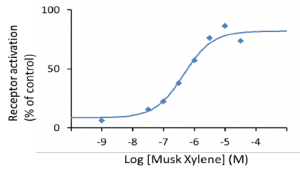
|
|
OR5AN1
Over the years, ChemCom has built a unique database pairing compounds to human Olfactory Receptors (hORs), not only on their agonist properties (ability to activate those receptor(s), but also on their enhancement (positive allosterism) or blocking (antagonist) properties. To complete the picture, these databases are nicely complemented with all available organoleptic and physical/chemical (experimental and/or predicted) information. This knowledge, which is growing daily, represents a clear competitive advantage to speed up all ongoing projects. To illustrate, here is one in-house example pairing a well-known nitro musk (Musk Xylene) with one described possible musk receptor (OR5AN1). Musk compounds represent a family of odorants of utmost importance for perfumery and fine fragrance creation. There has been a constant interest in finding new compounds that give off the typical note of musk.
The banning of the whole family of nitro musk and the threat to the polycyclic musk family has strengthened the search for efficient replacers. OR5AN1, which is exemplified here, is a described human olfactory receptor that only responds to some classes of musky compounds: nitro musk and ketone-containing macrocyclic musk. Polycyclic or linear musks are not able to activate this OR5AN1 receptor. Thus OR5AN1 is probably enabling panelists to differentiate those series from the other ones, but is probably not mediating the typical musky note. ChemCom has identified hORs that respond to compounds of all the different musk families.
| OR5AN1 | |
| Concentration-response |
|
| EC50 |
0.5 µM |
| Emax in % FSK |
82% |
| Average RNA copies number per 20ng RNA in olfactory epithelium |
377 ± 290 |
| Expression frequency in studied population |
100 % (26 out of 26 patients) |
| Musk Xylene | |
| Agonist name |
5-Tert butyl-2,4,6-Trinitro-meta-xylene |
| Agonist structure |
|
| Odor type |
Pleasant odor |
| Agonist odor |
Fatty dry sweet soapy musk |

